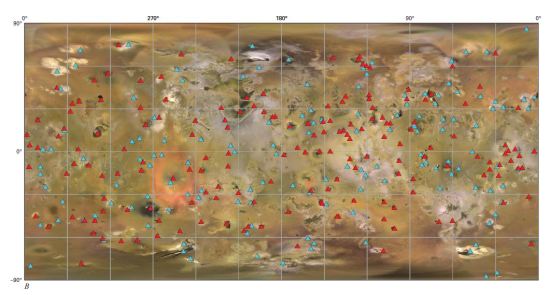Complete Geologic Map of Io Shows 425 Volcanoes But No Craters
Our own moon is something of a dead, crater-ridden boulder careening around the Earth, doing little of interest in the meantime. Sure, it’s got some interesting features and it probably has more than a few secrets left to be uncovered, but nothing is really going on up there. Jupiter’s moons, on the other hand, tend to be a little more active. Io, for example, has a vast sulfur landscape and hundreds upon hundreds of active volcanoes. Now, for the first time, we have a full geologic map of the moon’s surface, indexing all of its harsh alien glory, including 425 volcanoes and not a single crater.
The map was published by the U. S. Geological Survey, compiled by scientists from the Planetary Science Institute and Arizona State University, and shows the entirety of Io’s fascinating features like volcanoes, lava fields, sulfur plains, plume deposits, and mountain ranges. “Our mapping has determined that most of the active hot spots occur in [caldera-like depressions], which cover less than 3 percent of Io’s surface,” says David Williams of Arizona State University, the lead researcher involved in the map’s production. “Lava flow fields cover approximately 28 percent of the surface, but contain only 31 percent of hot spots,”
“Understanding the geographical distribution of these features and hot spots, as identified through this map, are enabling better models of Io’s interior processes to be developed.”
Although the map itself is fresh, the data used to create it isn’t what you might call new. Some of it’s what you might call old. The map was pieced from the Voyager 1 and 2 missions — those images having been acquired way back in 1979 — and the Galileo orbiter, which provided its images from 1995-2003. In the meantime, scientists have been poring over the images, enhancing different parts and adjusting for things like lighting differences. Now, after melding the 4 images together, they’ve completed the map we see today, which may not be accurate to Io right this second, but was accurate at some point.
As you might imagine, considering that it has 425 volcanoes, Io’s surface is changing quite frequently. So frequently in fact, that scientists found no impact craters; so far, Io is the only heavily researched body in the Solar System that’s able to boast this. While that doesn’t mean it hasn’t been hit by anything, it does show how fast Io’s volcano system refreshes the planet’s surface.
A static map isn’t the end of this project, though. Because Io changes so quickly — at least, from a geologic perspective — the plan is to create one database that can be continually updated as new information about Io is discovered. This way scientists can study not only the way Io is now (or was recently), but also the way it’s actively changing as time marches on. It almost makes you wish you lived on a violently volcanic, sulfur-rich moon that rapidly changes its surface through a perpetual series of hundreds upon hundreds of eruptions. Almost.
You can check out a huge PDF of the map here.
(via Universe Today)
- A short video showing what our moon went through before it was cool
- We may have once had two moons, which seems like it would have been awesome
- A nice look at a pair of Saturn’s moons
Have a tip we should know? tips@themarysue.com
